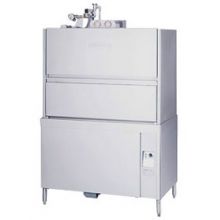DL SERVICES : As independent designers, we cater to our customers wishes, actively participating in new building and modernization / refit projects, putting together food flow concepts, lay-out designs with itemized budgeted equipment specifications, turnkey specifications and installation...
HOME » Warewashing Equipment » Utensils washer » Utensil washer Hobart
Utensil washer Hobart
UW50
General description
Easy to operate.
So easy, it’s automatic. The split opening doors provide spacious access for loading and unloading. The upper-door section slides upward as the lower door is pulled down to provide a shelf in which to pull the stainless steel pull-out rack onto, making it easier to load large utensils and pans. Easy-to-operate control and change cycles times make this versatile utensil washer a labor-saving necessity. Using only 2.1 gallons of water per rack, the UW50 is capable of washing up to 19 racks per hour.
Thoroughly clean ware. Three variable wash cycles (2, 4 or 6 minutes) ensure thorough cleaning and sanitizing by allowing you to match the cycle to the cleaning requirements of the load. Upper and lower revolving wash arms—with computer-designed, debossed, anti-clog nozzles—direct high-pressure wash flow to all soiled surfaces. Large, sloping, perforated stainless steel scrap screens direct food particles to a deep, stainless steel basket designed to remove food soil from the wash water. The rinse cycle achieves a final sanitizing 180°F.
Easy to clean. The sloping scrap screens, basket and strainer are easily removable for cleaning. The large opening afforded by the split door design makes cleaning the interior simple.
Durability is built in. The tank and hood are constructed of 16-gauge stainless steel. The frame, legs and adjustable feet are 14-gauge stainless steel. The door and door hinges are heavy-duty for long life and hard use. The scrap screen and bucket are also stainless steel.
The UW50 lets you select the length of the wash cycle to match the cleaning requirements of each load. The length of the wash cycle impacts the number of racks per hour, but not the amount of water used per cycle, which stays steady at 2.1 gallons.
QUICK FACTS
- All electric UW50 models are ENERGY STAR® qualified
- 16-gauge stainless steel construction for long life
- Solid-state heat controls
- Choice of wash cycles (2, 4 or 6 minutes) to match load requirements
- Gallons per cycle: 2.1
- Font-loading, split-door configuration for ease of use
- Chamber accepts 16 full-size sheet pans or 140-quart mixing bowl
- Two upper and two lower revolving, debossed, anti-clogging wash arms
- Heavy-duty door and door hinges for the busiest kitchens



